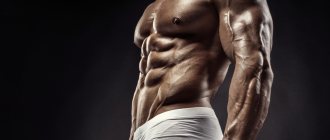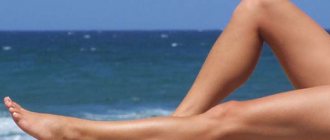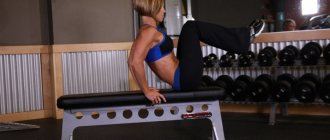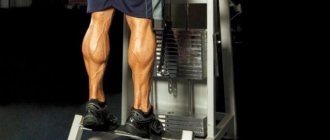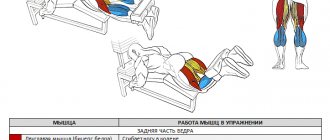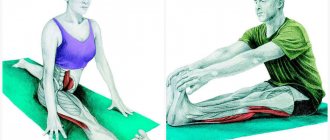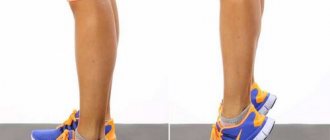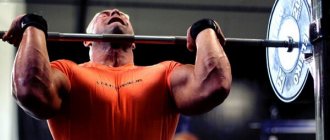How to get skinny calves!
During classes, we pay almost all our attention to making our hips, buttocks, bellies and sides thin, but we somehow forget about the calves, and meanwhile the calves are our part of the body that is almost constantly in sight! Unlike the hips and buttocks, calves are more difficult to reduce, but there are several special exercises that will help us with this problem!
Let's start with the equipment. You will need a thick book, a chair and dumbbells weighing 1 - 1.5 kg. It is also advisable not to forget about calves in everyday life. Show in full…. Show in full….
Train your calves at least twice a week, but preferably every other day. 15 minutes is enough. The main thing is for the muscles to get tired so that you feel a burning sensation in the calf muscles. But don’t overdo it, otherwise your calves will start to cramp at night!
Stretching for thin calves. Stretching is needed to prepare the calves for the main load and to make the muscles more elastic. In addition, stretching will help make your muscles sculpted and beautiful. You can replace one workout with stretching, or start your workout with one stretching exercise.
Alternating calf stretches with emphasis on the wall. Press against the wall with both hands. Lean towards the wall, bend one leg and place it forward, put the other back with a straight knee. The toe of the hind leg points straight ahead. Press the heel of your back foot into the floor and move your hips forward a little. Hold the maximum stretch position for 20 seconds. Repeat for the other leg.
Stretching both calves with emphasis on the wall. Stand with your feet together, about a meter from the wall. Lean forward without bending your back. Place your hands on the wall, continue to bend toward the wall (from your ankles), and do not lift your heels off the floor. You should feel tension in your calves. Be sure to keep your heels flat on the floor or as close to it as possible. Keep your stomach pulled in to prevent your lower back from flexing. To increase tension, bend your elbows, pushing your chest toward the wall.
Bent over calf stretch. Lean forward, leaning on your hands, so that the angle between your legs and torso is approximately 90 degrees. Relax your legs and begin to alternately slowly bend and straighten your knees on one and then the other leg.
Calf stretch by toe. Stand straight, take a step back with your left foot and transfer your center of gravity to it. Lean your body forward, grab your right toe with your right hand and pull it towards you as far as possible. Back straight! Stay in this position for half a minute. Repeat on the other leg.
Basic exercises for skinny calves. The main exercise for thin calves is calf raises in various variations. It should be borne in mind that the calves react to load differently than other muscles. Calves are difficult muscles and require more time and effort to work on them. When working with calves, you need to make sure that there is not too much stress on your back and spine.
Raising on your toes in a sitting position. Sit on the edge of a chair with your back straight. Place a thick book under your feet. Place one dumbbell between your knees and bend your legs so that one of your toes is touching the book. Lower your heels 3-5 cm closer to the floor. Then slowly, forcefully, lift your heels until you are on your toes. Also slowly and forcefully return to the starting position.
Standing calf raises. Place a chair and place a thick book on the floor behind it. Take a dumbbell in your left hand and stand on a book so that your heels are hanging. The book should be so thick that when you sit on your heel, you do not stand on the floor, but only touch it. Raise your right leg so that your foot is level with the knee of your left leg, and then lower your left heel as low as possible. Slowly stand on your toes. Then return to the starting position. Repeat the exercise, changing legs and transferring the dumbbell to the other hand.
Calf squats. Place your left leg forward, squat down on it a little, and stretch your right leg back as far as it will go. Keep your hands behind your head, your elbows out to the sides, and your back should be straight. In this position, bend your whole body forward towards your left leg, trying to reach your knee with your chest. Repeat 15 to 50 times for each leg. After this exercise, tingling in the thighs is possible.
Climb the steps on your toes - that's where the load is! Climb the steps slowly - slowly, transfer all your weight to your supporting leg, trying to feel the tension in your calf muscles. At home.
Walk at home on your toes! At the stove - on tiptoes. Around the room - on tiptoes. Sit at the computer with your feet on your toes!
General Tips
Experts have developed a number of recommendations for those people who decide to reduce the size of their calves. The advice should be followed regardless of whether the classes are carried out independently at home or under the guidance of an experienced instructor.
An important rule that you should take as a basis for your training is to start your workout with warm-up exercises. After this, you should perform stretching, and then the main complex. The work must be completed with a massage of the calf muscle.
Before training, you should not eat for 2-3 hours. After exercise, you should also refrain from eating. A snack can be made after 2 hours; it should consist of light, quickly digestible food.
You won't be able to achieve beautiful, slender legs unless you change your diet. A balanced diet should include as many fresh fruits and vegetables as possible. It is necessary to exclude any fatty or flour products.
Drinks such as coffee, energy drinks and soda are very harmful to the body. During physical activity, the body especially needs fluid. You need to drink at least 2 liters of filtered water only.
Meals should be fractional: a person should eat at least 5–6 times a day, keeping portions small. Wanting to achieve a sporty, fit figure, everyone should approach this issue comprehensively. Physical activity should be supplemented with yoga, dancing, visiting the pool, etc.
Procedures such as massage and wraps should be added to active loads. You can strengthen muscle mass through massage sessions.
The effect on the body will help accelerate blood circulation, which will have a beneficial effect on metabolic processes. A good metabolism is the key to rapid weight loss, since it allows you to quickly absorb useful substances and remove unnecessary ones.
Massage movements can be of different types, including rubbing, patting or kneading. Experts often use mittens for greater effect. The massage can be accompanied by the use of various products, such as sea salt, honey or essential oils.
It is important to remember that gentle, painless sensations will not be effective. You should work with the body at an intense pace.
You can reduce the volume of your calves using wraps. It is better to do them after training. Thanks to the wraps, blood flow increases, which helps burn fat and relieve fatigue.
Before the procedure, you should take a shower, thoroughly cleansing the skin of your feet with a scrub. Then seaweed, honey or another product is applied to problem areas and the leg is wrapped in cling film. Warm pants are worn on top.
You should feel pleasantly warm for the next 30 minutes. After this, the product is washed off and the skin is lubricated with nourishing cream. Wraps are done after 1–2 days.
Muscle stretching
Before performing muscle stretching exercises, it is necessary to warm them up. This will help avoid possible injuries. Gymnastics, jumping or light running in place can be a good way to prepare the body for the subsequent load.
Then perform the following exercises:
- Place your feet shoulder-width apart and begin to slowly lower your body. You need to reach to the tips of your toes and bring your head as close to your shin as possible. This position is fixed for 15 seconds. Do 4–5 approaches.
- You need to kneel down, stretch your right leg forward, and pull your foot towards you. The body should be pressed against the extended limb as much as possible. Keep your arms parallel. Remain in this position for 15 seconds, and then do the same task for the left leg. Repeat the exercise for 4-5 approaches.
- You should lie on the floor, bend your left leg, and clasp your knee with your hands. The right foot should be on the floor. The knee is pressed to the body, trying to reach it to the chest, while the feet are lowered as much as possible. You need to be in this position for 1 minute.
- Stand up straight, feet shoulder-width apart. The right leg is pulled back, while the left leg remains in place. The right heel should be pulled towards the floor surface. The smallest possible angle should be formed between the foot and the lower leg. If the exercise is performed correctly, a burning sensation will be felt in the tendon area.
- Lying on your stomach, your legs rest against the wall so that your toes are on the floor and your heel is pressed against the wall. You need to hold the position for 1–2 minutes.
- Sit on the floor, stretch your legs forward, keeping them next to each other. Bend over, trying to reach the tips of your toes with your hands, and press your body as close to your outstretched legs as possible. Stay in this position for as long as possible, increasing the period over time.
Stretching can sometimes be used in the middle of performing a set of exercises, for example, after a lot of physical activity on the legs when performing the Pistol.
Elliptical training
The elliptical trainer is an effective tool for those who want to reduce the size of their calves. This device is a type of cardio machine that simulates running.
Exercise using this type of equipment will be safe for the joints and will help stretch the calf muscles, which will make them slimmer. The maximum load can be achieved if the torso is tilted forward and the arms are fixed on fixed handrails.
Run
Running will help you get rid of excess fat in your calves and also change their shape. Despite the fact that the effect of this type of load is not achieved quickly, the result lasts a long time.
However, running will only bring benefits if a person adheres to important rules. So, you need to run for at least 30 minutes, without stopping to rest. The running pace should be the same.
You should not choose places where the path goes uphill or downhill. Resistance training, on the other hand, will cause muscle tissue to grow, resulting in bigger calves.
Swimming
Swimming will not only help you get rid of excess weight, but will also give definition to your legs and make your legs thin and beautiful. The result will be possible if intensive work is carried out in the water, for example, breaststroke swimming.
Before going into the water, you need to warm up on land. Then they swim at a slow pace for 10–15 minutes, after which they move on to a faster pace.
Swimming is effective when a person swims as fast as possible for 20–30 seconds, and then slows down the speed for 20–30 seconds. You should alternate between different paces from 8 to 10 times per hour.
How to make your calves on your legs slim and lean. A set of exercises at home
Not only aerobic exercise and stretching, but also various exercises for the problem muscle group will help make your calves thin.
There are many exercises for losing weight from the calves, let's look at the most common ones that can be performed both at home and on the street.
Jumping rope
Jumping rope is the easiest type of exercise to perform that involves the calf muscles. When jumping, keep your back straight, use only your hands, and land on your toes. Jump rope starting at 5 minutes, progressing to a 30-minute workout.
Jump rope, landing on your toes, not your entire foot! This way, you soften the impact force upon contact with the floor. Jumping rope has contraindications, consult your doctor before starting exercise.
Alternating rise on toes
Place your feet wider than your shoulders, bend your knees, and point your toes out. Rise onto your toes alternately, first with your right foot, then with your left. Repeat up to 20 approaches. Internal calf muscles are involved.
Pistol
Stand straight, bend your left leg at the knee, use your hands to help maintain balance. Rise up onto the toe of your right foot and lower onto your foot. Repeat until your muscles are tired at a fast pace. Repeat up to 20 approaches. Do the same exercise with your left leg. The lower leg muscle group works.
Calf raise #1
Stand straight, feet shoulder-width apart, hands on your waist, feet apart. Rise onto your toes and lower onto your feet at maximum speed until your muscles fatigue. Perform up to 20 repetitions. This exercise works the inner side of the shin.
Calf raise #2
The starting position is the same as in the previous exercise, but turn your feet inward. Rise onto your toes and lower onto your feet at a fast pace until your muscles fail. Perform up to 20 repetitions. This exercise works the outer calves.
In addition to the above exercises, step aerobics is a good element for losing weight not only in the lower leg, but also in the entire body.
Workout to reduce calf size
The following types of physical activity will help make your calves more graceful:
- swimming;
- cycling on a flat plane;
- exercise on an exercise bike without additional resistance;
- jumping rope - when performing the exercise, it is important to land on your toes, and not on your entire foot;
- race walking;
- jogging on a flat surface;
- running in place;
- “Plank” exercise;
- pistol squats.
The exercise time should be 30–40 minutes. They definitely need to be combined. For example, 20 minutes of jogging, followed by 20 minutes of race walking. Or 10 minutes of exercise on an exercise bike, and then 20 minutes of swimming in the pool.
Attention! Before developing a set of exercises to reduce leg volume, it is important to make sure that there is no swelling. Edema causes kidney problems, poor diet, and cardiovascular diseases.
How to make your calves thin. Stretching exercises
Stand up straight, bring your right leg forward, and take your left leg back as far as possible. Exhale, bend down and place your palms on the floor. Legs should be straight. Pull the toe of your right foot towards you, then away from you. Inhale, rise up, do the same, switching legs. Repeat 15-20 times.
Place your feet together, extend your arms above your head. Inhale and begin to stretch upward, seemingly lengthening your spine. Exhale, lower your torso to your hips, place your palms on your shins, and stretch your chest forward. Stay in this position for a minute.
Remaining in this position, relax the upper part of your body one hundred percent, transfer all your own weight to your toes. After a few minutes, lift yourself up over your back.
You may feel the muscles in your calves, hamstrings, and tendons behind your knees become very tight, which is great.
Advice!
Sitting on the floor, stretch your legs forward and raise your arms up. Exhale and stretch your crown upward; as you exhale, bend your chest toward your hips. Breathing should be directed into the tummy. With each subsequent exhalation, try to relax your legs and bend down as low as possible. Freeze in this position for a minute. Take the starting position.
Lying on the floor, stretch your legs up without bending your knees. Use your fingers to grab your toes and pull your legs toward you for about a minute. As you exhale, bend your legs at the knees and lower them to the floor. Breathe evenly and relaxed during the exercise.
Jumping on one leg will also help make your calves thinner. Do as many jumps as you have the strength to do, then change legs. The exercise should be done very quickly. If you do not want to jump, do alternating rises on your toes, but also at the highest speed. The faster you do the exercises, the more effectively you will lose muscle mass.
How to remove volume in calves. Causes of full calves and features of working with them
To reduce the size of your calves, you need to try to understand the causes of this problem. The matter may be a hereditary predisposition and a particular physique, in which the entire figure will be dense and stocky. In this case, you will have to work for a long time, but you can still get results.
Also, the shins may increase in size due to varicose veins and fluid retention. Pay attention to symptoms such as severe fatigue in your legs in the evening, a feeling of heaviness and burning in them.
Too full calves can be a consequence of excess weight, as well as uneven weight loss. First of all, volumes disappear from the arms, chest and abdomen, but problem areas in the lower body may remain rounded, despite constant efforts.
Having determined what is causing the fullness of your calves, you must fight the cause. Most often, you need to reconsider your diet and lifestyle, move more, and drink enough clean water.
In addition, if you want to reduce your shin, you can't do without exercises aimed specifically at this area. There are special complexes that are recommended to be supplemented with stretching exercises, thanks to which the muscles will become elastic and toned. The calves themselves are strong and resilient muscles, it is thanks to them that we can move throughout the day. Because of this, they are difficult to correct. To achieve results, you need to exercise regularly - at least 2-3 times a week. It is also important to choose the right set of exercises.
Full calves, what to wear. How to dress if you have fat legs
Often, girls with full legs are embarrassed by their appearance and begin to hide it behind bulky clothes, trying to appear more inconspicuous. However, this is not a reason to refuse stylish things that will help turn the lack of a figure into its advantage.
Instructions
1
Full legs and wide hips need to be balanced with a slimmer upper body by choosing clothes and shoes to make your figure look proportionate. To draw attention away from your legs, choose blouses and tops in light colors, and skirts and trousers in dark colors. Jackets should not end at mid-thigh, but rather at the narrower top. Tunics, tops and dresses may also be present in your wardrobe. Just choose not baggy models that will visually add extra pounds, but those that match your size. Be sure to accentuate your waist with wide belts, belts or corsets, but do not tighten them too much.
2
The choice of skirt should be given special attention. The ideal option is a model with a good cut and a straight silhouette, five centimeters below the knees. They will visually make your figure slimmer and your legs beautiful. Styles such as “octagonal” or “trapeze” will also look great. But leave the tapered ones in the store for other fashionistas, because such skirts will not only not decorate you, but will also add volume to your figure. Tights should be dark and thin, as tight knitting will only emphasize the fullness of the legs.
3
Women with full legs can and should wear trousers. A good choice would be straight or dark-colored styles that flare out at the bottom. Don't go past classic blue jeans that you can pair with tunics. The edges of the legs should end approximately in the middle of the heel, which will also make the legs look sleeker.
4
When choosing shoes, medium or high-heeled shoes will help you elongate your figure and give slender legs. Avoid shelves with flat or square toes. Mid-calf boots are also not for you.
Helpful advice
Beautiful large beads, a scarf gracefully tied around your neck, and the right makeup will not only emphasize your beauty and charm, but will also distract attention from your lower body.
How to reduce pumped calves. How to remove inflated calves on your legs with exercises in a week?
Many women are dissatisfied with the size of their legs or legs in general and dream of reducing their calves even through surgery. But is this really the only way?
Simple rules for every day
In fact, there are less expensive and dangerous methods that you can use:
- Do not walk on your toes, as this will strain your shins. A high heel maintains muscle tone, and this promotes responsive growth, like any activity associated with toning the legs, be it ballroom dancing, or even jumping rope. Everything is individual. For some, jumping and dancing will result in a decrease in the volume of the lower leg, for others - an increase. Track the results with a measuring tape and don’t panic;
- Run to reduce the thickness of your legs. Running is a powerful weight loss tool, but it's worth comparing the physiques of short- and long-distance runners. Athletes who run marathons have thin legs, while sprinters have powerful thighs and calves. Long distance running on flat terrain, at low speed and without acceleration is the answer to the question of how to remove fat from calves and legs in general;
- Avoid activities that require development of stamina, power and leg speed - this leads to muscle growth. For example, short intense cardio workouts, running on hills and incline treadmills, and jumping jacks build large calf muscles in response to exertion;
- Resistance training can be kept as part of an active lifestyle, but use light weights and high repetitions. If you need to eliminate fat around the calf muscles, you will need to limit carbohydrates in your diet and increase the amount of cardio;
- Stretching makes the leg muscles longer and slimmer - stretching, yoga and Pilates classes are recommended for everyone who wants to become fit without building up calf muscles.
Avoid intense jumping, including jumping rope, in interval training. Swimming, walking, cross-training, and the elliptical machine can all help you lose weight in your calves. Walking lengthens the muscles between the back of the knee and ankle. Avoid steppers, as they pump up the calf muscles;
Tips and precautions
- Your diet also plays an important role in losing weight. A balanced diet that allows you to get rid of excess fat deposits without compromising muscle mass is called body drying. To achieve your goal, you need to eat low-fat foods. These foods include fruits and vegetables, and you need to increase their content in your diet.
- Ask a doctor who specializes in physical therapy to analyze your walking habits. Perhaps you mostly use your calf muscles when walking, which results in large calf muscles.
- Remember that genetics also play a major role in the size and proportion of your calves. If you are predisposed to having large calf muscles, then losing them will require more effort and more time.
- Try to walk on sidewalks, as they are usually level, which will avoid the high risk of spraining your ankle and will also tone your calves.
- Avoid walking in high heels for long periods of time. In addition to the possible problems that can arise with your leg joints and your back, constantly walking in high heels leads to excessive development of the calf muscles.
- Check with your doctor before you start a new exercise plan or diet. This consultation is important as you may have some health problems that may limit your lifestyle and some physical activities.
Originally posted 2018-01-09 08:48:24.
How to reduce inflated calves. Removing calves with exercises
Removing calves on the legs is quite difficult, since fat practically does not accumulate in the lower leg area, and its shape depends on the calf muscle. The fat layer may increase, especially in the cold season, but regular walking allows you to quickly restore your calves to their former slimness. Therefore, the best way to get rid of excess calf volume is to do a lot of long-distance walking. The advantage of walking is that it is suitable for everyone, regardless of fitness level.
How to remove calves from legs in a week is a question that many people ask. It is quite difficult to cope with the problem in such a short period of time, but there is no need to rush, because the result is more important. Jumping helps burn fat, but it also strengthens muscles, so you need to know how to properly include it in your program.
In order to quickly burn fat without pumping up your calves, it is recommended to combine three types of loads in your program:
- multi-repetition strength;
- cardio;
- stretching.
Exercises should be performed for a minute without taking breaks. First, rise on your toes without dumbbells. Then jump from side to side. If breathing becomes difficult, pauses are acceptable. Do side jumps, skater style. They involve jumping from foot to foot, in which you need to tilt your body and move your bent leg back.
Dedicate the fourth minute to the plie position: place your feet wider than your shoulders, squat down and lift your heels off the floor one by one.
Fifth minute - stretching exercises against the wall. Put one leg back, rest your hands on the wall and lean forward, bending your left leg at the knee and touching the floor with your right heel. Spend 30 seconds on each leg.
The sixth last minute is devoted to stretching while bending over. One leg is placed forward on the heel. You need to lean forward with your body, keeping your back straight and pull your toes towards you.
This simple six-minute program helps in how to remove large calves. There are also a huge number of exercises aimed at burning fat in the lower leg area. You can find a separate article on this topic on the website, where the exercises are illustrated with photographs (link).
Exercises for the gym
When working on your calves in the gym, you need to contact an experienced instructor. Based on the physiological and physical characteristics of a person, he will be able to create the most suitable program, including different types of load, including isolating exercises.
It is most often suggested to use sports equipment that involves working on flexion and extension of the knee joints, bench presses in a sitting or lying position. The use of exercise bikes and treadmills is effective.
The benefit of exercise machines is that when used, the load will be distributed evenly, which is not always possible to achieve when working independently at home.
How to stretch your calves. 1 Stretching exercises on the floor
- 1
Hamstring stretch. This stretch will help you stretch not only your hamstrings, but also your calf muscles. Try moving your ankles in circles to strengthen them. You can also rest your feet on a wall to stretch your calf muscles.
2
Stretching for the calf muscles. Stand on a step and lower your heels below the level of the step to give your calves a good stretch. To stretch each leg individually, bend your left leg and place your left foot completely on the top step. Lower your right foot down one step. Then switch legs. You can also do this exercise on a bench if you can find something to hold on to for balance.
3
Quadriceps stretch with a fitness ball. This exercise will allow you to stretch your thigh muscles while sitting on a ball in a lunge position. To make the exercise more challenging, you can rest your hips on the ball, bend your knee so that your heel touches your butt, and pull on your ankle to stretch the thigh muscles on that leg. Repeat this exercise on the other leg.
4
Stretching the quadriceps muscles from a standing position. For this exercise you will need to stand between two chairs of the same height. You can use a wall to support your back leg if you don't have two suitable chairs. As you perform this exercise, tighten your abdominal muscles to keep your pelvis straight and take pressure off your lower back.
Naturally big calves. About calves
To understand how this exercise can make even the tiniest legs grow, you need to understand the unique characteristics of the calves. The calves are made up of several muscles, but the two most important workhorses of a bodybuilder, the ones that he pays most attention to, are the gastrocnemius and soleus muscles. The calf muscles are more tense when the knees are straight (standing calf raises). The soleus muscles work when the knees are bent (seated calf raises). It is worth noting that the soleus muscles are partially stimulated during standing lifts. The soleus muscle has a larger volume of “slow” muscle fibers, up to 88%. This is the largest percentage of such fibers in the human body. Therefore, the number of repetitions for the soleus muscle should be higher. Most traditional calf workouts do not take this feature into account and do not provide sufficient load for this “endurance” muscle. This is no good, because it is a significant volume of load at a good intensity that can lead to hypertrophy. Lifting significant weight, such as your body weight, every day for a high number of repetitions will definitely lead to muscle growth. Since this workout does not involve heavy loads, it can be done daily. It is the frequency of training that forces the body to adapt quickly. At first everything will hurt, but it's not that bad.
Why do the calves get bigger? Ways to reduce calves on legs
- Standing straight, place your feet shoulder-width apart, and lower your arms and relax. As you inhale, slowly lift your heels off the floor and rise onto your toes. Repeat the exercise twenty times;
- Standing straight, bend your left leg at the knee. After inhaling, rise up on your toes. Do the exercise 15 times, and then repeat the same actions with the second leg;
- Standing straight, spread your feet shoulder-width apart. Point your socks inward. Inhaling, slowly rise up on your toes. Repeat thirty times;
- Stand on the threshold so that your heels hang down. Straighten your back. To maintain balance, grab a wall or chair with your hands. Stay in this position for a couple of seconds and lower yourself onto a flat surface of the floor. Then stand on the threshold again and lower yourself to the floor. Repeat the exercise fifteen times;
- Place one leg forward. Place your hands on your hips and straighten your back. Bend your extended leg at the knee and try to squat as low as possible. This exercise helps stretch the muscles in the back of your thighs and calves. If you want to improve the result, try to put your leg as far as possible, but your hands should always be on your hips. Do the same exercise for the second leg.
Girls' calves. Why do calves get fat?
Calves are muscles that take an active part in human walking. But why, these calves increase in size in girls, thereby reducing the attractiveness of their legs. The reasons for this may be the following:
- Edema. The first reason for enlarged calves is the presence of swelling in the legs. In this case, the legs gradually become larger and new problems appear: varicose veins, fungus. You can find out that enlarged calves are directly related to swelling of the legs by looking at your legs, or more precisely, at your ankles. If, after taking off your socks, you notice reddened spots on your ankles, then this is actually a consequence of swelling.
But this is not the only way to determine the presence of swelling in the legs. You can also determine the presence of swelling, which is the cause of enlarged calves, by putting on shoes. To do this, you should observe how the process of putting on shoes in the morning and taking them off in the evening occurs. If in the evening shoes or boots are removed with great difficulty, then the presence of edema is obvious. - Completeness. If a woman suffers from excess
weight, it is possible that her calves will also be of the appropriate size. But such an increase in calves is not at all associated with the development of the muscular system, but rather the opposite. In this case, the legs are simply covered with layers of fat, which are quite problematic to get rid of quickly. But it is possible to do this, and for this you only need desire, patience and some knowledge. You can gain knowledge from this material, but you can stock up on patience and desire yourself. - Excessive training. But this is very rare among women, but only among those who devote their entire lives to sports. Moreover, sport in this case is difficult; in fact, heavy loads lead to pumping of muscles and significant release of them on the legs. Enlarged calves due to training are quite easy to distinguish from swollen or fatty legs.
Why do pores on the face increase with age? How to deal with enlarged pores on the face
Most girls and women take care of their appearance, trying to look their best. Care includes many stages, from hygiene to makeup and clothing.
But even if you achieve perfect results in all aspects of your appearance, it is impossible to feel truly beautiful if you have skin problems. We are not necessarily talking about any very noticeable defects, such as acne or age spots.
Enlarged pores, which are so common in women of all ages, can also spoil the overall picture. But it is worth noting that this problem does not bypass men either.
Enlarged pores on the face: causes
Under normal conditions, pores have a tiny diameter that is only noticeable upon closer inspection. This is enough to remove sebum and, in turn, protect the pores from external contaminants getting inside. Healthy skin is smooth and clean thanks to good regulation.
With enlarged pores, the skin becomes spongy and visually loose, and the surface ceases to be smooth. The particles are clearly visible, dirt accumulates in them, and sebum is released more strongly.
All this provides fertile ground for the occurrence of comedones and acne, as well as various pimples. In addition, aesthetically, such skin does not look very pleasant; it becomes grayish, shiny, and has an uneven structure.
Enlarged pores are a fairly common occurrence. What is causing this problem:
- hormonal disruption or surge: many women discover any skin problems precisely at moments of redistribution of hormones in the body, which occur, for example, during pregnancy, menopause, during puberty or before menstruation;
- violation of the regime and improper nutrition: pores are a kind of channel for removing harmful substances from the body simultaneously with skin secretions; any failures affect all systems, including the glands; if the regime is violated and very spicy, fatty or sweet foods predominate in the food, the volume of sebum increases, so the pores expand;
- the use of low-quality or unsuitable skin care products: the external effect on the skin is very important; with incorrectly selected skin care cosmetics, the skin begins to behave in an unusual way, including pores enlarged, and various contaminants enter them, which, when mixed with secretions, form acne and blackheads;
- low-quality decorative cosmetics: foundations and powders most often cause deterioration of the skin, as they cover it, closing the pores; Waterproof products can be especially harmful, as they block the skin’s access to oxygen exchange more than others;
- problems with the gastrointestinal tract, which also affect the entire body;
- impaired metabolism;
- overdrying of the skin in the sun, as well as when using alcohol lotions and other cosmetics that affect the pH balance;
- oily skin, which may be due to a hereditary factor;
- bad habits: the effects of alcohol and smoking affect all systems of the body, which, trying to get rid of toxins, resorts to all possible methods of removing them.
